The basis of most of the buildings in the private sector is a reinforced concrete foundation. Is it a sturdy and reliable design? able to withstand heavy loads and stand without damage for 100 years or more. But the manufacture of a support system of this type is a complex and multi-stage process, one of which is the removal of the formwork after concreting. Its implementation must be approached competently in all respects, since mistakes can entail the most sad consequences.
Maturation of concrete
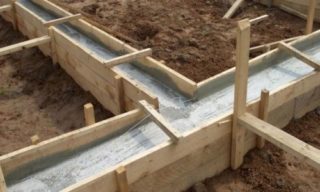
In the initial state, concrete is a liquid substance of high density and low fluidity. To give it the desired shape, formwork is used - a vertically oriented frame that determines the boundaries of the distribution of the mixture - the width and height of the base. The material for the manufacture of the form can be rented or it is made in-house from what is at hand.
After what time the formwork is removed from the foundation depends on several criteria. The main ones are:
- The composition of the mixture. Concrete is a substance that is almost entirely composed of mineral components. Calcium silicate is intended for curing, and calcium aluminate accelerates the physicochemical reactions occurring in the solution.
- Air temperature. In warmth, concrete ripening occurs faster, in cold weather it slows down. Methods for heating and cooling support systems have been developed.
- Concrete curing technology. Ideal conditions are constant temperature and humidity, regular watering of the plate, covering it with a protective material.
- Supplements. Plasticizers and accelerators help to reduce the time of foundation hardening.
The curing time of concrete is variable. It is necessary to decide when it is possible to remove the formwork in relation to each specific case, correctly assessing all the accompanying conditions.
The concept of "maturation" should be approached in a differentiated manner. Complete assumes the passage of the entire cycle of hardening and gaining strength. This means that you can use the foundation without any restrictions, loading it with the design capacity. There are also intermediate stages when the solution no longer needs support, but it still retains some looseness and fragility. These steps can be used to perform alignment, sanding and drilling of utility holes.
Standards for stripping formwork
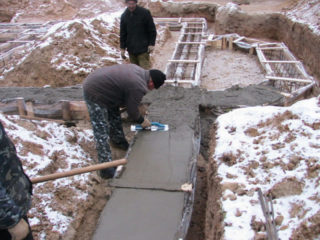
The terms for removing the formwork from the reinforced concrete casting are regulated by SNiP 3.03.01-87 "Bearing and Fencing Structures".
With a slab length of up to 600 cm, the brand strength should be at least 70%. If the side is longer, 80%. In this case, the maximum load on the foundation is allowed up to 3.5 MPa.
The document also contains a table of the degree (%) of concrete ripening depending on the average daily ambient temperature.
| Temperature | Days since filling | ||||||||
| 1 | 2 | 3 | 5 | 7 | 10 | 14 | 21 | 28 | |
| -3 | 3 | 6 | 8 | 12 | 15 | 22 | 26 | 30 | 35 |
| 0 | 4 | 8 | 10 | 15 | 18 | 25 | 29 | 32 | 38 |
| 3 | 5 | 10 | 15 | 20 | 25 | 30 | 35 | 40 | 45 |
| 5 | 6 | 12 | 18 | 24 | 30 | 36 | 42 | 48 | 54 |
| 10 | 8 | 14 | 21 | 28 | 35 | 42 | 50 | 57 | 65 |
| 15 | 10 | 20 | 30 | 40 | 50 | 60 | 70 | 80 | 90 |
| 20 | 12 | 21 | 32 | 44 | 55 | 66 | 77 | 88 | 95 |
| 25 | 18 | 30 | 35 | 50 | 57 | 70 | 80 | 90 | 100 |
| 30 | 20 | 33 | 45 | 58 | 71 | 80 | 90 | 100 | |
Following the indicators of the table, you need to focus on 70%. When the required date comes, you can dismantle the formwork. You should not be guided by the season. Air humidity must be taken into account. With dampness, the wood swells, it leads, which can cause the destruction of a fragile foundation.In such situations, it is allowed to remove the formwork at a maturation level of 50%. If porous fillers or rubble stone are used, 30%, but then loading concrete is categorically contraindicated. The foundation must reach 100% maturation.
How long does it take to remove the formwork after concreting
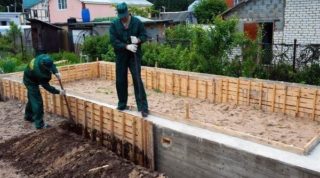
Building a foundation is a long process; it is almost impossible to complete it during the ripening period. A fragment of a pit, tamping the bottom, filling, reinforcement, installation of formwork - all this can take more than one month. Plus, 28 technological days after pouring are added.
Here you need to take into account the following nuances:
- If construction begins in late spring or early summer, the pouring will coincide with the onset of the heat, which is extremely dangerous for maturing concrete. From high temperatures, it dries too quickly, unevenly, which leads to a decrease in strength and the appearance of cracks.
- When the foundation is made in the fall, there is a risk of sudden frost. This phenomenon in the first 1-3 days can provoke the crystallization of water in the solution and the complete destruction of the manufactured structure.
Builders recommend pouring the foundation in late summer and early autumn in order to have time to remove the formwork before the onset of cold weather when the concrete is fully ripe. Leaving the form for the winter is not recommended. Metal items can be stolen, and wood will swell and rot. Nothing will happen to the foundation itself, the extra months of endurance will only benefit it.
As practice shows, on 2-3 days after pouring, the concrete hardens so much that it transfers minor loads without the risk of damage, to which the careful dismantling of the formwork can be equated. A prerequisite for such a decision is the complete exclusion of access to the foundation by outsiders, including children and animals. But it is better to wait a week if the plan for pouring the support system allows.
Dismantling of the formwork depending on the external conditions and the load on the building
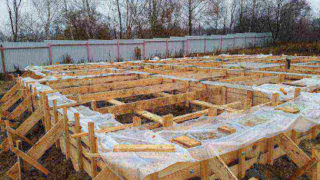
Despite its strength in finished form, concrete needs to be cared for almost immediately after pouring and throughout the entire curing period. At the end of this process, the mortar must be leveled, check the strength of the form and, if necessary, correct it. Then the structure should be fenced in order to exclude mechanical damage. After a day, the foundation should be covered with a film - this will prevent rapid evaporation of water from its surface. On the third day, concrete should be watered. The higher the air temperature, the more often.
One of the criteria influencing the period for removing the formwork is the design load that will be exerted on the support system.
The following minimum standards are defined for various buildings:
- frame houses - 50%;
- buildings made of foam blocks - 60%;
- construction of oak logs - 70%;
- brick mansion - 80%.
The weather condition has no less influence on the timing of the removal of the formwork. In the cold, concrete ripening occurs very slowly, sometimes it takes up to two months. In the heat, the mixture completely solidifies by the end of the third week. The fact that the shields can be removed is evidenced by the formation of gaps between them and the strip foundation.
Dismantling tips
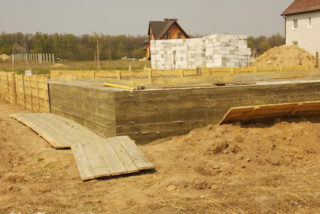
The removal of the formwork can only be started with full confidence that the concrete has gained sufficient strength for this. This is mandatory for sub-bases and floor slabs.
It is recommended to observe the following rules for dismantling molding structures:
- Removal must be carried out very carefully so as not to damage the base and shields, which can be reused for various economic purposes.
- It is better to start removing the formwork from the places where the mortar hardens the fastest - corners and edges.
- Disassembly is always carried out from top to bottom.First, the fasteners are removed, then the boards and boards are separated. If the bolts and screws are rusted, they are cut off with a grinder.
- Usually, after removing the spacers and stops, the formwork falls off by itself. If this does not happen, it should be done with sharp and wide wooden wedges by applying weak blows.
- In places of communication holes, you need to be especially careful, since in such places the foundation is weakened.
- It is not allowed to use heavy construction equipment and a sledgehammer to separate the shields. It is better to wait a few days until the concrete is fully ripe and the load is not terrible for it.
If the removed formwork cannot be disposed of, it must be cleaned, dried and stored in a dry storage area. It is preliminarily recommended to treat wood with a primer and antiseptic, and metal with grease.









The article is about nothing. The standards are given for floor slabs, and the foundation is described. Nobody immediately loads the foundation up to the design load, so you can remove the formwork the next day and continue construction work. Small frosts in spring are not terrible for concrete, and in winter or late autumn, at subzero temperatures, it is heated and covered. In the heat, the concrete is moistened and covered. Floor slabs at the factory are steamed in autoclaves, so they can be mounted immediately after leaving the factory. In the open air, stoves are made only by private traders who do not have steaming. It is better not to take such plates. You need to look at the manufacturing technology, otherwise the stove may fall on your head.
After pouring the foundation, when the milk leaves (this is half a day), cover all 5 cm with a layer of sawdust and water intensively every day twice for 10 !!! days, after only it is possible to remove the formwork and, if the construction time allows, continue watering for another 20 days! Then clean from sawdust and leave to dry.